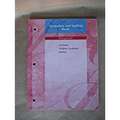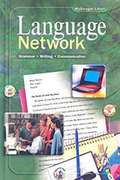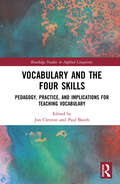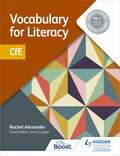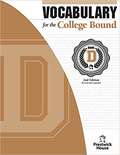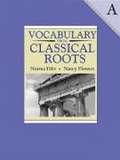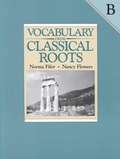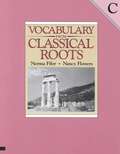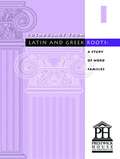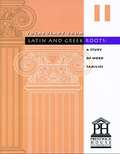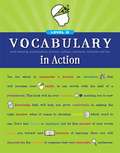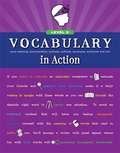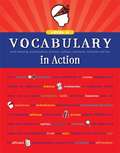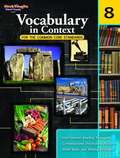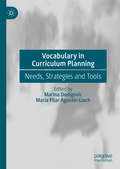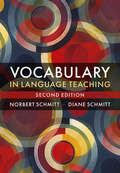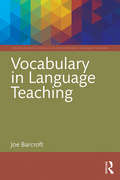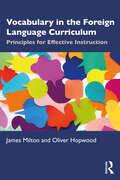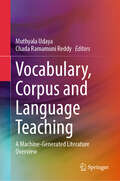- Table View
- List View
Vocabulary and Spelling
by Mcdougal LittellThe Vocabulary and Spelling Book contains lessons designed to help you understand and remember important vocabulary skills and strategies. You will often need to use basic reference sources to master these new techniques and to complete the exercises within the book.
Vocabulary and Spelling Book (Grade #8)
by Mcdougal LittellThe Vocabulary and Spelling Book contains lessons designed to help you understand and remember important vocabulary skills and strategies. You will often need to use basic reference sources to master these new techniques and to complete the exercises within the book.
Vocabulary and the Four Skills: Pedagogy, Practice, and Implications for Teaching Vocabulary (Routledge Studies in Applied Linguistics)
by Jon ClentonThis edited volume provides a single coherent overview of vocabulary teaching and learning in relation to each of the four skills (reading, writing, listening, speaking). Each of the four sections presents a skill area with two chapters presented by two leading experts in the field, relating recent advances in the field to the extent that each skill area relates differently to vocabulary and how this informs pedagogy and policy. The book opens with a summary of recent advances in the field of vocabulary, and closes by drawing conclusions from the skill areas covered. The chapters respond to emerging vocabulary research trends that indicate that lexical acquisition needs to be treated differently according to the skill area. The editors have chosen chapters to respond to recent research advances and to highlight practical and pedagogical application in a single coherent volume.
Vocabulary for Literacy: CfE
by Jane Cooper Rachel AlexanderSyllabus: CfE (Curriculum for Excellence, from Education Scotland) and SQALevel: BGE (S1-S3) and Senior Phase (National 4/5)Subject: LiteracyWords are powerful. Enrich your vocabulary and you will be able to speak, listen, read and write more effectively.Explore important aspects of vocabulary - decoding words, easily confused words, groups of words and new words - through simple explanations, strategies, progressive activities and revision tasks.This is the only book available that includes a dedicated chapter on inclusive language, to teach pupils how their words can make people feel accepted and understood.Vocabulary for Literacy equips pupils with the building blocks for success in exams, coursework and adult life, and facilitates literacy development across the curriculum.> Understand the essentials. Key concepts that pupils need to remember are introduced in 'explanation' boxes.> Put theory into practice. 'Building', 'Strengthening' and 'Extending' tasks enable pupils to apply their knowledge and skills, through a mix of solo and group work.> Check and consolidate. 22 photocopiable A-Z activity sheets at the end of the book can be used flexibly for classwork, homework, revision or assessment.> See the big picture. 'Crossover' boxes make links to prior and future learning, knowledge and skills, encouraging pupils to approach vocabulary holistically.> Avoid common errors. 'Mistake' boxes contain examples and tips to ensure that pupils get it right in their own speech and writing."There is a proven link between an improved vocabulary and increased attainment in Scottish schooling."Rachel Alexander
Vocabulary for Literacy: CfE
by Jane Cooper Rachel AlexanderSyllabus: CfE (Curriculum for Excellence, from Education Scotland) and SQALevel: BGE (S1-S3) and Senior Phase (National 4/5)Subject: LiteracyWords are powerful. Enrich your vocabulary and you will be able to speak, listen, read and write more effectively.Explore important aspects of vocabulary - decoding words, easily confused words, groups of words and new words - through simple explanations, strategies, progressive activities and revision tasks.This is the only book available for the Scottish curriculum that includes a dedicated chapter on inclusive language, to show students how their words have the power to make everyone feel accepted and understood.Vocabulary for Literacy equips pupils with the building blocks for success in exams, coursework and adult life, and facilitates literacy development across the curriculum.> Understand the essentials. Key concepts that pupils need to remember are introduced in 'explanation' boxes.> Put theory into practice. 'Building', 'Strengthening' and 'Extending' tasks enable pupils to apply their knowledge and skills, through a mix of solo and group work.> See the big picture. 'Crossover' boxes make links to prior and future learning, knowledge and skills, encouraging pupils to approach vocabulary holistically.> Avoid common errors. 'Mistake' boxes contain examples and tips to ensure that pupils get it right in their own speech and writing.> Check and consolidate. 22 printable A-Z activity sheets (available for free online) can be used in school or at home for revision and extra practice."There is a proven link between an improved vocabulary and increased attainment in Scottish schooling."Rachel Alexander
Vocabulary for the College Bound, Level 12 (Second Edition)
by Prestwick House<p>For 25 years and counting, teachers have trusted Vocabulary for the College Bound because it works and the brand-new 2nd Edition is even better. <p>We've revised the whole series and added new lessons that focus on academic and domain-specific words from various subjects: science, math, social studies, health, and English. <p>Vocabulary for the College Bound will: <p> <li>Help schools meet Common Core State Standards with domain-specific word lists <li>Add rigorous nonfiction passages to your curriculum <li>Teach students to decipher word meanings from roots, prefixes, and suffixes <li>Ensure long-term word retention with varied, challenging exercises</li> </p>
Vocabulary for the College-Bound Student
by Harold Levine Norman Levine Robert T. LevineTo provide meaningful, organized vocabulary improvement for the high school student whose goals may be college admission, a responsible position, or self-improvement.
Vocabulary for the High School Student (4th edition)
by Harold Levine Norman Levine Robert T. LevineThe principal aim of this updated and enlarged edition is to help high school students build a superior vocabulary and learn the skills of critical thinking, close reading, and concise writing. The exercises in this edition have been written expressly to teach these and other desirable skills at the same time as vocabulary.
Vocabulary from Classical Roots A
by Norma Fifer Nancy FlowersIdeal for students mastering a growing content-area vocabulary in social studies, science, and mathematics multisyllabic Greek- and Latin-based words help students unlock the meanings of literally thousands of words.
Vocabulary from Classical Roots B
by Norma Fifer Nancy FlowersVocabulary from Classical Roots is a thematically organized vocabulary program based on Greek and Latin roots. You will become acquainted with constellations of words descended from Greek and Latin, visible in families that cluster around such subjects as the human being, kinds of mental activity, and aspects of daily life. The book is ideal for students mastering a growing content-area vocabulary in social studies, science, and mathematics multisyllabic Greek- and Latin-based words.
Vocabulary from Classical Roots C
by Norma FiferVocabulary from Classical Roots encourages you to look at words as members of families in the way astronomers see stars as parts of constellations. You will become acquainted with constellations of words descended from Greek and Latin, visible in families that cluster around such subjects as the human being, kinds of mental activity, and aspects of daily life.
Vocabulary from Classical Roots 5
by Mountain LeeIdeal for students mastering a growing content-area vocabulary in social studies, science, and mathematics-predominantly multisyllabic Greek and Latin-based words-Vocabulary from Classical Roots helps students unlock the meanings of literally thousands of words, and gives them the skills to do so throughout their lives.
Vocabulary from Latin and Greek Roots: A Study of Word Families, Book 1
by Paul Moliken Elizabeth OsborneIn this etymology-based vocabulary program,units are organized by meaning rather than alphabetically and it aims to increase retention of new words as well as to expand students' vocabulary.
Vocabulary from Latin and Greek Roots: A Study of Word Families, Book 2
by Elizabeth OsborneVocabulary from Latin and Greek Roots shows students how thousands of words share common elements: roots, prefixes, and suffixes derived from Latin and Greek.
Vocabulary in Action (Level D)
by The Editors at the Loyola PressThe book focuses on student's vocabulary development with the choice of words chosen based on frequency, occurrence, and relevance to the real world.
Vocabulary in Action (Level E)
by Loyola PressVocabulary in Action- Vocabulary Workbooks Welcome to the NEW Vocabulary in Action, the premier vocabulary development program! With this comprehensive program, students study and learn hundreds of words that were researched and selected for frequency, occurrence, and relevance to the real world as well as standardized assessment. Consumable student books pair with online resources and teacher instruction to provide vocabulary instruction that is introduced, reinforced, and applied in engaging, systematic ways. The Vocabulary in Action workbook is designed to improve oral and written vocabulary through interactive vocabulary practice, giving students the gift of a larger and more descriptive vocabulary.
Vocabulary in Action (Level H)
by Loyola PressWelcome to the NEW Vocabulary in Action, the premier vocabulary development program! With this comprehensive program, students study and learn hundreds of words that were researched and selected for frequency, occurrence, and relevance to the real world as well as standardized assessment. Consumable student books pair with online resources and teacher instruction to provide vocabulary instruction that is introduced, reinforced, and applied in engaging, systematic ways. The Vocabulary in Action workbook is designed to improve oral and written vocabulary through interactive vocabulary practice, giving students the gift of a larger and more descriptive vocabulary.
Vocabulary in Context for the Common Core Standards, Grade 8
by Steck-VaughnProvides exercises designed to stimulate vocabulary growth, offers specially designed sections to build skills required for standarized tests, and introduces three hundred new words.
Vocabulary in Curriculum Planning: Needs, Strategies and Tools
by Marina Dodigovic María Pilar Agustín-LlachThis edited book brings together a collection of perspectives and studies on the role and potential uses of vocabulary assessment in second and foreign language learners' needs analysis. Assessing what vocabulary a student already knows - and what therefore might be a realistic goal for language learning - is an essential aspect of developing and delivering effective foreign language classes. The chapters in this book address what has so far been an under-researched aspect of classroom needs analysis, exploring the influence of vocabulary tests, the lexical profiles of teaching materials, and learner as well as teacher beliefs and practices. This book will be of interest to students and scholars of applied linguistics and TESOL, language teachers and teacher trainers, and educators engaged in assessment and evaluation.
Vocabulary in Language Teaching (Cambridge Language Education Ser.)
by Norbert Schmitt Diane SchmittInternationally recognised as one of the leading texts in its field, this volume offers a comprehensive introduction to vocabulary for language teachers who would like to know more about the way vocabulary works. Two leading specialists make research and theory accessible, providing the background knowledge necessary for practitioners to make informed choices about vocabulary teaching and testing. This second edition retains the popular format of the first edition, and has been rewritten to take account of the many developments in the past 20 years. There is a greater focus on the vocabulary learning process, with new chapters on incidental learning, and intentional learning, and a new wide-ranging discussion of formulaic language. The book now also includes extensive treatment of word lists and vocabulary tests, with explanations of their various strengths and limitations. Updated further reading sections, and new Exercises for Expansion make this volume more invaluable than ever.
Vocabulary in Language Teaching (The Routledge E-Modules on Contemporary Language Teaching)
by Joe BarcroftThis module focuses on the pivotal role of vocabulary in language acquisition, communication, and instruction. It first reviews the nature of vocabulary knowledge, the mental lexicon, and different contexts of vocabulary learning. It then explains how we acquire vocabulary and refine vocabulary knowledge over time. The primary emphasis is on how language instructors can promote evidence-based vocabulary instruction in the classroom. To this effect, the module highlights some telling research on the effects of specific tasks (such as sentence writing and copying target words) and different ways of presenting target words (such as having multiple talkers instead of a single talker produce the target words) and outlines an effective approach to vocabulary instruction, one that emphasizes multiple presentations of target vocabulary, specificity in the relationship between task type and learning outcomes, and the gradual build-up of language-specific vocabulary knowledge over time. A sample lesson based on this approach is also provided. Please visit the series companion website for more information: http://routledgetextbooks.com/textbooks/9781315679594/
Vocabulary in the Foreign Language Curriculum: Principles for Effective Instruction
by James Milton Oliver HopwoodWritten by experts in the field, this book explains the principles of effective vocabulary instruction for the modern language classroom. While many language classrooms rely on practices which can be outdated, idiosyncratic or ill-advised, this book overviews the research and background necessary to successfully integrate vocabulary instruction into the curriculum in a systematic way. Starting with the common gaps in vocabulary instruction, Milton and Hopwood demonstrate how students’ development of a large, communicative lexicon, with an understanding of word structure and collocations, is an essential component of language instruction. The book addresses goal setting, curriculum design, word selection, how words are learned, learning in and outside of the classroom and more. It also addresses common myths about teaching vocabulary in the United Kingdom and around the world. This comprehensive text fills an important gap in the literature and is ideal for undergraduate and postgraduate courses in world language/foreign language methods and language methods courses.
Vocabulary, Corpus and Language Teaching: A Machine-Generated Literature Overview
by Muthyala Udaya Chada Ramamuni ReddyThis book is the result of a collaboration between a human editor and an artificial intelligence algorithm to create a machine-generated literature overview of research articles analyzing the importance of ESL/EFL vocabulary and corpus studies. It is a new publication format in which state-of-the-art computer algorithms are applied to select the most relevant articles published in Springer Nature journals and create machine-generated literature reviews by arranging the selected articles in a topical order and creating short summaries of these articles.This comprehensive book explores ESL/EFL vocabulary and corpus studies from five main perspectives: acquisition, strategies, ICT, corpus, and current practices. The sections delve into topics such as the impact of technology on learning, the power of corpora in language education, and innovative vocabulary-development techniques.This book is an essential resource for researchers, educators, and language facilitators seeking a deeper understanding of vocabulary within ESL/EFL teaching and learning contexts.
Vocabulary, Spelling, Poetry
by Ed. D. James A. ChapmanStimulate your child's analytical and memorization skills with Vocabulary, Spelling, Poetry V. This text puts an emphasis on the origin of vocabulary words; word analysis through the study of prefixes, roots, and suffixes; word analogies; synonyms and antonyms; and classic poetry. <p><p>This text is broken down into 12 units; each unit includes 12 vocabulary words, 2 sets of 15 spelling words, a list of prefixes, roots, and suffixes; and 5 word exercises to help implement new concepts. Nine well-known poems are also included for recitation and memorization to enhance the appreciation of poetry.
Vocabulary, Spelling, Poetry I
by James A. ChapmanWhile your child works hard at mastering the words and definitions from his spelling lists each week, this book helps reinforce the correct usage of those words. With twenty-eight weekly quizzes and four quarterly review quizzes, your child’s spelling and vocabulary skills will be evaluated and strengthened. Some of the exercises include applying spelling rules, using words in correct context, recognizing synonyms, and underlining misspelled words. You will also find eight well-known poems for recitation and memorization to enhance your child’s appreciation of poetry.
